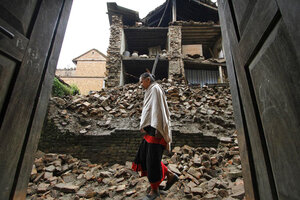6.9 magnitude quake 'a wake-up call' to Nepal
A magnitude-6.9 earthquake left 50 dead in Nepal, India, and Tibet. The slow response to the quake in Nepal puts a spotlight on a dismal disaster preparedness record.

A Nepalese woman passes by debris of collapsed buildings damaged by a magnitude 6.9 earthquake that shook northeastern India on Sunday night, in Katmandu, Nepal, Monday, Sept. 19. Rescue workers used shovels and their bare hands to pull bodies from the debris of collapsed buildings Monday, as the death toll from an earthquake that hit northeast India, Nepal and Tibet rises.
Niranjan Shrestha/AP
Kathmandu, Nepal
A magnitude-6.9 earthquake rattled most of Nepal Sunday, leaving at least six dead and some 24 seriously injured. The slow response to the quake puts a spotlight on Nepal’s dismal disaster preparedness record, despite a history of devastating earthquakes.
In Nepal, where seismologists have been warning that the region is due for “the big one,” people were relieved to read media reports that described the quake’s impact as relatively mild. The quake, centered in the Indian state of Sikkim, killed more than 50 people across India, Nepal, and Tibet.
“There is scant preparedness for a major quake,” says Suraj Shrestha, a civil engineer associated with National Society for Earthquake Technology – Nepal (NSET), a nongovernmental organization that seeks to build earthquake-safe communities in Nepal by 2020.
Nepal was fortunate because the epicenter was located far enough from major Nepalese cities to prevent more serious damage, Mr. Shrestha says.
[ Video is no longer available. ]
Most of the country has been too busy focusing on how to respond to the Maoist insurgency that gripped the country for a decade until 2006. The country has yet to secure long-term peace.
The last time a major quake hit Nepal was in 1988. The magnitude-6.5 quake that hit the country then killed 721 people. Before that, the biggest recorded quake to strike the region was a magnitude-8.3 in 1934 that killed some 8,519 people, according to the government’s National Seismological Center.
Nepal introduced quake-resistant building code for the first time in 2003. But the code covers only a handful of cities, including the capital, Kathmandu. The code was the government’s response to the 1988 quake.
“Enforcement of the code remains very poor,” Shrestha says.
According to an estimate by the NSET, some 80 percent of the buildings in the country are not earthquake resistant.
“The risk is high. Yesterday’s quake was a wake-up call,” added Shrestha, who says he hopes the quake will lead to more stringent enforcement of building codes.
A study conducted by NSET in 1998 predicts that a quake measuring more than a magnitude-8 on the Richter scale would kill some 100,000 people and destroy 70 percent of the buildings in Kathmandu, destroy bridges, cripple power supply, and clog the city’s notoriously narrow roads, making it difficult for the city’s poorly equipped firefighters to respond to fires and ambulances to reach the injured.
The government’s National Emergency Operation Center, set up to deal primarily with the annual floods and landslides responsible for dozens of deaths each year, is undermanned and underequipped to respond to devastation of a major quake.
About 12 civil servants operate the center that principally works as an information-gathering nucleus in times of natural disasters, says Maiya Kandel, an official at the center under the Internal Affairs Ministry.
“We have some trained rescue teams in the security forces apart from working relations with various organizations that operate ambulances,” says Ms. Kandel.
But in practice, the center mainly helps journalists update disaster toll figures.
“The best way to respond to Sunday’s earthquake is by starting an initiative to build stronger buildings, reinforce weaker ones, reinforce bridges, and prepare emergency services such as fire engines, ambulances, and hospitals to deal with a bigger quake,” says NSET’s Shrestha.
